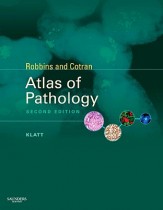Robbins and Cotran Atlas of Pathology by Edward C. Klatt MD contains more than 1,500 high-yield medical images, including clinical and intraoperative photographs, pictures of gross pathology specimens, blood smears, H&E stains, electron micrographs, funduscopic and endoscopic images, plain radiographs, CTs, ultrasonographic images, MRIs, and many other.

The pictures are generally clear and clinically relevant, with authoritative and concise accompanying text.
Much, if not most, of the contents of the book is still relevant to me now as a third year resident in internal medicine. The chapters on hematopathology and red blood cell disorders are particularly well done. Covered are both very common and very rare diseases, from iron deficiency anemia and sickle cell disease to leishmaniasis, babesiosis, trypanosomiasis and filariasis.
I’ve always wondered about the absence of EKGs in pathology courses and texts, including this one. Many, if not most, people in developed nations die of an arrhythmia or of a myocardial infarction. Thus, I think it would be quite fair for future editions of this book to show important electrocardiogram, such as those demonstrating hyperkalemia, torsades de pointes, STEMI, and pericarditis.
In addition, I would recommend adding Gram stains in selected areas as well. These could give the authors dedicated space in which to focus exclusively on the microbiology of important diseases like acute bacterial cystitis and meningitis.
This is one of the very best medical books of all time and one of the best basic sciences books for medical students. I recommend it very highly to medical students and to anyone who is otherwise interested in pathology.


Leave a Reply